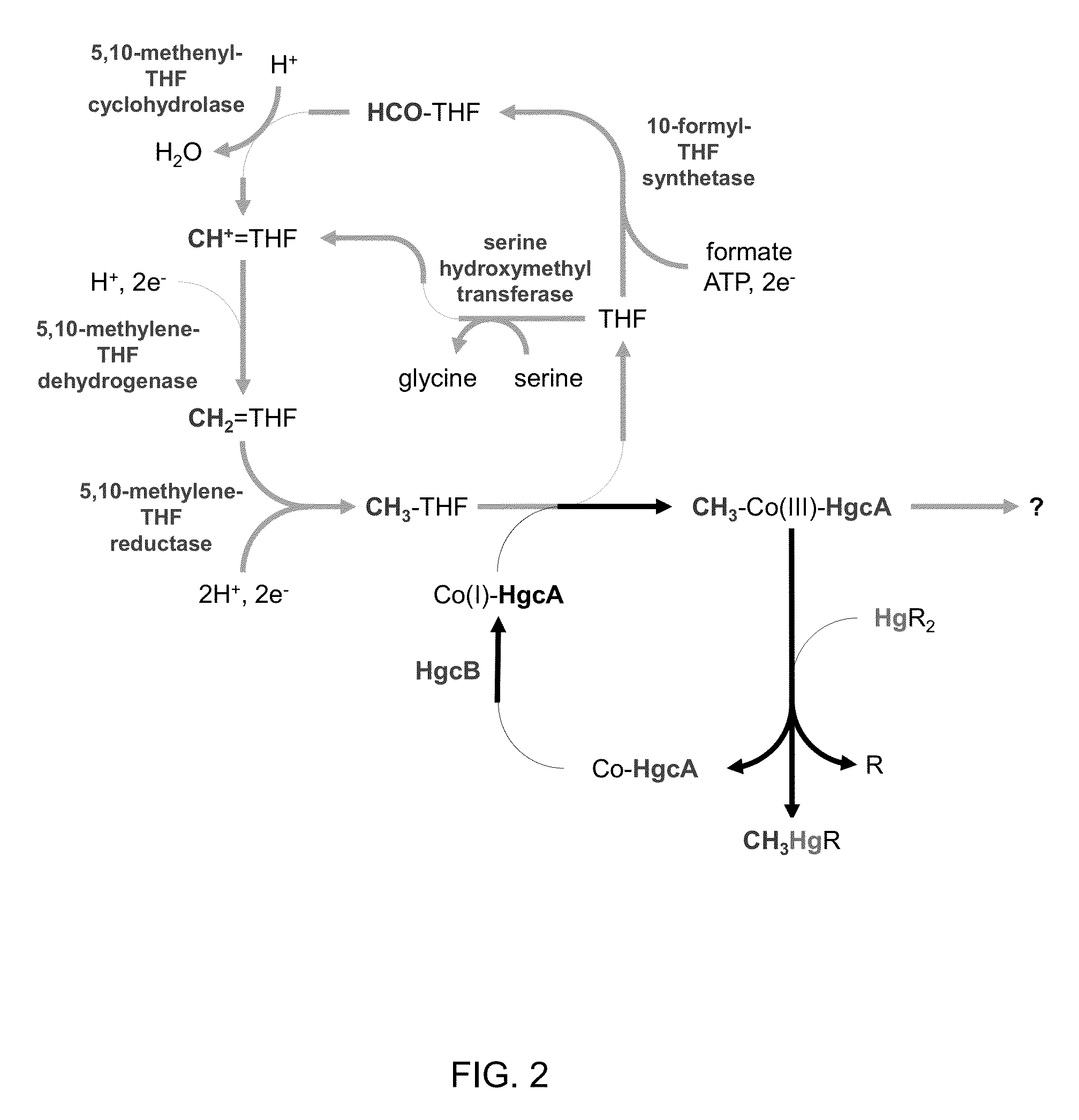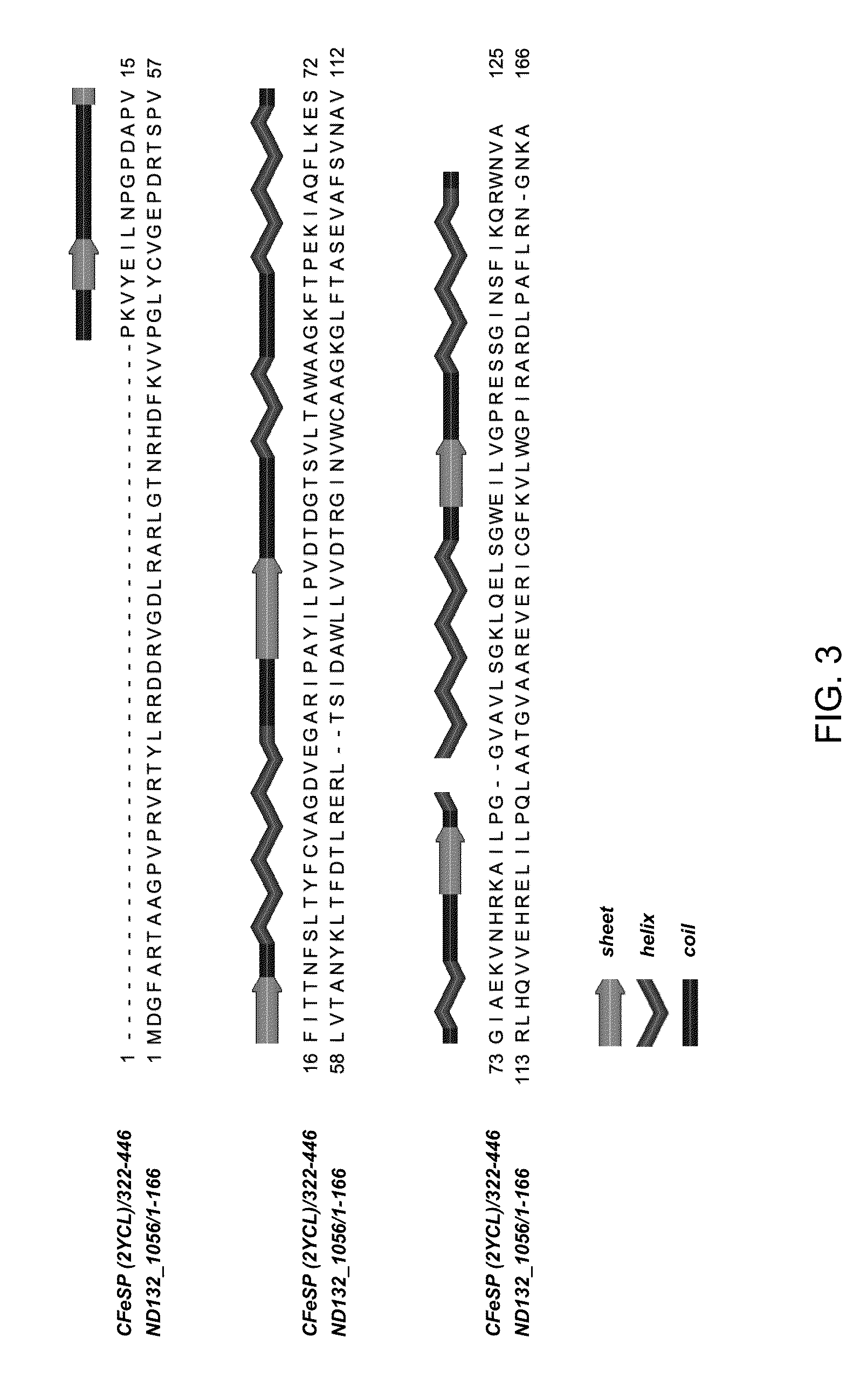Mercury methylation genes in bacteria and archaea
a technology of mercury methylation and genes, applied in the field of mercury methylation genes in bacteria and archaea, can solve the problems of strain loss, high toxic to humans and other organisms, and the inability of phylogenetic analyses based on 16s sequences to distinguish between methylating and non-methylating microorganisms
- Summary
- Abstract
- Description
- Claims
- Application Information
AI Technical Summary
Benefits of technology
Problems solved by technology
Method used
Image
Examples
example 1
Identification of Hg Methylation Genes
[0067]The corrinoid iron-sulfur protein (CFeSP) from Moorella thermoacetica (Ragsdale 1987, Kung 2012) and Carboxydothermus hydrogenoformans (Svetlitchnaia 2006, Goetzl 2011) transfers a methyl group to its substrate acetyl-CoA synthase as a carbocation (CH3+) (Banerjee 2003), suggesting that a similar corrinoid protein might stabilize the Co(III) state, enabling transfer of a methyl group to a Hg(II) substrate to yield methylmercury.
[0068]A BLAST search was performed according to Altschul (1997) using the 445 amino acid sequence of the large subunit of CFeSP from C. hydrogenoformans Z-2901 (CsfA; locus tag CHY—1223) (see also, UniProtKB: Q3ACS3; GenBank: ABB14598.1) against the translated genome sequence of the confirmed methylator D. desulfuricans ND132. The search yielded a partial match in a single gene with a sequence identity of 28% (51% similarity) for the C-terminal residues 306-441 of CFeSP (FIG. 3) with the gene in D. desulfuricans ND1...
example 2
Structural Analysis of HgcA and HgcB Genes
[0076]The N-terminal domain of HgcA is similar to the cobalamin-binding domain of CFeSP (PDB 2YCL; FIG. 3). Protein sequence alignment and modeling of the three-dimensional structure of the putative cobalamin-binding domain of HgcA indicated that it likely binds a corrinoid cofactor in a “5,6-dimethylbenzimidazole-off (DMB-off), histidine-off (His-off)” configuration (Ragsdale 2008a) similar to CFeSP (FIG. 7). Furthermore, alignment of the cobalamin-binding domain sequences shows a highly conserved motif, with a consensus sequence of N[V,I]WCA[A,G]GK (SEQ ID NO. 6), within the region of highest similarity to the CfsA subunit of CFeSP (FIG. 8) which is embraced within a slightly longer consensus sequence of TxG[I,V]N[V,I]WCA[A,G]GK[G,D,K,Q][T,L,S,A]F (SEQ ID NO. 204) as described in Example 1.
[0077]The lower-axial cobalt ligand in corrinoid proteins plays a role in the chemistry of Co—C bond cleavage (Banerjee, 2003). The HgcA region of highe...
example 3
Functional Analysis of the hgcA and hgcB Genes and Gene Products
Deletion and Complementation Studies:
[0079]Overall Results:
[0080]To establish the role of HgcA and HgcB in mercury methylation, these genes were deleted, either individually or as a pair from D. desulfuricans ND132. Additionally, the pair or hgcA alone was deleted from G. sulfurreducens PCA. Methylation activity was verified by two independent methylation assays. In each case, deletion of one or both genes resulted in abolition of mercury methylation activity by greater than 99% relative to the wild-type level. Complementation of the two-gene cluster restored 26% and 87% of wild-type activity in D. desulfuricans ND132 and G. sulfurreducens PCA, respectively, when measured by ICP-MS (FIG. 10). Deletion and subsequent complementation of hgcB alone in D. desulfuricans ND132 yielded D. desulfuricans ND132 and G. sulfurreducens PCA restored 90% and 79% of wild-type activity; whereas, complementation of D. desulfuricans ND132...
PUM
| Property | Measurement | Unit |
|---|---|---|
| size | aaaaa | aaaaa |
| time | aaaaa | aaaaa |
| voltage | aaaaa | aaaaa |
Abstract
Description
Claims
Application Information
 Login to View More
Login to View More - R&D
- Intellectual Property
- Life Sciences
- Materials
- Tech Scout
- Unparalleled Data Quality
- Higher Quality Content
- 60% Fewer Hallucinations
Browse by: Latest US Patents, China's latest patents, Technical Efficacy Thesaurus, Application Domain, Technology Topic, Popular Technical Reports.
© 2025 PatSnap. All rights reserved.Legal|Privacy policy|Modern Slavery Act Transparency Statement|Sitemap|About US| Contact US: help@patsnap.com



